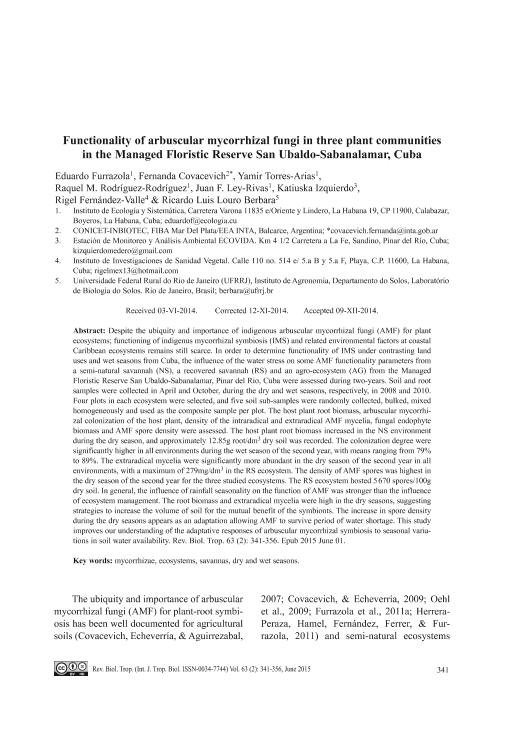Mostrar el registro sencillo del ítem
dc.contributor.author
Furrazola, Eduardo
dc.contributor.author
Covacevich, Fernanda

dc.contributor.author
Torres Arias,Yamir
dc.contributor.author
Rodriguez Rodriguez, Raquel M.
dc.contributor.author
Ley Rivas, Juan F.
dc.contributor.author
Izquierdo, Katiuska
dc.contributor.author
Fernandez Valle, Rigel
dc.contributor.author
Berbara, Ricardo Luis Louro
dc.date.available
2017-02-02T19:05:55Z
dc.date.issued
2015-01
dc.identifier.citation
Furrazola, Eduardo; Covacevich, Fernanda; Torres Arias,Yamir; Rodriguez Rodriguez, Raquel M.; Ley Rivas, Juan F.; et al.; Functionality of arbuscular mycorrhizal fungi in three plant communities in Managed Floristic Reserve San Ubaldo-Sabanalamar, Cuba; Universidad de Costa Rica; Revista de Biología Tropical; 63; 2; 1-2015; 341-356
dc.identifier.issn
0034-7744
dc.identifier.uri
http://hdl.handle.net/11336/12366
dc.description.abstract
Despite the ubiquity and importance of indigenous arbuscular mycorrhizal fungi (AMF) for plant ecosystems; functioning of indigenus mycorrhizal symbiosis (IMS) and related environmental factors at coastal Caribbean ecosystems remains still scarce. In order to determine functionality of IMS under contrasting land uses and wet seasons from Cuba, the influence of the water stress on some AMF functionality parameters from a semi-natural savannah (NS), a recovered savannah (RS) and an agro-ecosystem (AG) from the Managed Floristic Reserve San Ubaldo-Sabanalamar, Pinar del Rio, Cuba were assessed during two-years. Soil and root samples were collected in April and October, during the dry and wet seasons, respectively, in 2008 and 2010. Four plots in each ecosystem were selected, and five soil sub-samples were randomly collected, bulked, mixed homogeneously and used as the composite sample per plot. The host plant root biomass, arbuscular mycorrhizal colonization of the host plant, density of the intraradical and extraradical AMF mycelia, fungal endophyte biomass and AMF spore density were assessed. The host plant root biomass increased in the NS environment during the dry season, and approximately 12.85g root/dm3 dry soil was recorded. The colonization scores were significantly higher in all environments during the wet season of the second year, with means ranging from 79% to 89%. The extraradical mycelia were significantly more abundant in the dry season of the second year in all environments, with a maximum of 279mg/dm3 in the RS ecosystem. The density of AMF spores was highest in the dry season of the second year for the three studied ecosystems. The RS ecosystem hosted 5 670 spores/100g dry soil. In general, the influence of rainfall seasonality on the function of AMF was stronger than the influence of ecosystem management. The root biomass and extraradical mycelia were high in the dry seasons, suggesting strategies to increase the volume of soil for the mutual benefit of the symbionts. The increase in spore density during the dry seasons appears as an adaptation allowing AMF to survive period of water shortage. This study improves our understanding of the adaptative responses of arbuscular mycorrhizal symbiosis to seasonal variations in soil water availability.
dc.format
application/pdf
dc.language.iso
eng
dc.publisher
Universidad de Costa Rica

dc.rights
info:eu-repo/semantics/openAccess
dc.rights.uri
https://creativecommons.org/licenses/by-nd/2.5/ar/
dc.subject
Micorrizas Arbusculares
dc.subject
Ecosistemas
dc.subject
Savana
dc.subject
Estaciones Humeda y Seca
dc.subject.classification
Otras Ciencias de la Tierra y relacionadas con el Medio Ambiente

dc.subject.classification
Ciencias de la Tierra y relacionadas con el Medio Ambiente

dc.subject.classification
CIENCIAS NATURALES Y EXACTAS

dc.title
Functionality of arbuscular mycorrhizal fungi in three plant communities in Managed Floristic Reserve San Ubaldo-Sabanalamar, Cuba
dc.type
info:eu-repo/semantics/article
dc.type
info:ar-repo/semantics/artículo
dc.type
info:eu-repo/semantics/publishedVersion
dc.date.updated
2016-12-07T18:13:26Z
dc.journal.volume
63
dc.journal.number
2
dc.journal.pagination
341-356
dc.journal.pais
Costa Rica

dc.journal.ciudad
San Jose
dc.description.fil
Fil: Furrazola, Eduardo. Instituto de Ecología y Sistemática; Cuba
dc.description.fil
Fil: Covacevich, Fernanda. Consejo Nacional de Investigaciones Científicas y Técnicas. Centro Científico Tecnológico Mar del Plata. Instituto de Investigaciones en Biodiversidad y Biotecnología; Argentina. Instituto Nacional de Tecnología Agropecuaria. Centro Regional Buenos Aires. Estación Experimental Agropecuaria Balcarce; Argentina
dc.description.fil
Fil: Torres Arias,Yamir. Instituto de Ecología y Sistemática; Cuba
dc.description.fil
Fil: Rodriguez Rodriguez, Raquel M.. Instituto de Ecología y Sistemática; Cuba
dc.description.fil
Fil: Ley Rivas, Juan F.. Instituto de Ecología y Sistemática; Cuba
dc.description.fil
Fil: Izquierdo, Katiuska. Estación de Monitoreo y Análisis Ambiental ECOVIDA; Cuba
dc.description.fil
Fil: Fernandez Valle, Rigel. Instituto de Investigaciones de Sanidad Vegetal; Cuba
dc.description.fil
Fil: Berbara, Ricardo Luis Louro. Universidade Federal Rural do Rio de Janeiro; Brasil
dc.journal.title
Revista de Biología Tropical

dc.relation.alternativeid
info:eu-repo/semantics/altIdentifier/url/http://revistas.ucr.ac.cr/index.php/rbt/article/view/14682
dc.relation.alternativeid
info:eu-repo/semantics/altIdentifier/doi/http://dx.doi.org/10.15517/rbt.v63i2.14682
dc.relation.alternativeid
info:eu-repo/semantics/altIdentifier/url/http://www.redalyc.org/articulo.oa?id=44938603003
Archivos asociados
